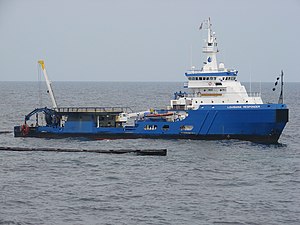Responder class: Difference between revisions
Jump to navigation
Jump to search
George Swan (talk | contribs) (add another) |
George Swan (talk | contribs) (add reference) |
||
| Line 59: | Line 59: | ||
| [[File:Pollution control vessels in Galveston.jpg|75px]] || ''[[Texas Responder]]'' || [[Galveston, Texas]] || <ref name=msrcGalvestonTX/> | | [[File:Pollution control vessels in Galveston.jpg|75px]] || ''[[Texas Responder]]'' || [[Galveston, Texas]] || <ref name=msrcGalvestonTX/> | ||
|- | |- | ||
| [[File:Oil recovery vessel W.C. Park Responder drills in how to respond to an oil spill in 2019 - 190523-G-BA041-333.jpg|75px]] || ''[[W.C. Park Responder]]'' || [[]] || | | [[File:Oil recovery vessel W.C. Park Responder drills in how to respond to an oil spill in 2019 - 190523-G-BA041-333.jpg|75px]] || ''[[W.C. Park Responder]]'' || [[Port Angeles, Washington]] || <ref name=msrcPortAngelesWA/> | ||
|} | |} | ||
==References== | ==References== | ||
{{Reflist|refs= | {{Reflist|refs= | ||
<ref name=msrcPerthAmboyNJ | <ref name=msrcPortAngelesWA> | ||
{{cite news | |||
| url = https://www.msrc.org/equipment-capabilities/equipment/site/18 | |||
| title = Site equipment inventory: Port Angeles, WA, Terminal 3 | |||
| work = [[Marine Spill Response Corporation]] | |||
| author = | |||
| date = | |||
| page = | |||
| location = | |||
| isbn = | |||
| language = | |||
| trans-title = | |||
| archiveurl = | |||
| archivedate = | |||
| accessdate = 2022-08-07 | |||
| url-status = live | |||
| quote = | |||
}} | |||
</ref> | |||
<ref name=msrcPerthAmboyNJ> | |||
{{cite news | {{cite news | ||
| url = https://www.msrc.org/equipment-capabilities/equipment/site/17 | | url = https://www.msrc.org/equipment-capabilities/equipment/site/17 | ||
Revision as of 20:51, 8 August 2022
The Responder class is class of oil recovery vessels, built in 1992 and 1993.[1]
These vessels can deploy a boom, and use it to suck up leaks of oil, and other liquids that float on water.[1] They also have room to provide a command center when it is joined by smaller oil recovery vessels.
The vessels require on a crew of 6 mariners. The boom requires an additional 7 oil recovery specialists. The vessels can carry a complement of 38.[1]
The Pacific Responder was the first vessel launched.
Specifications
| Length | 63.5 m (208.33 foot) |
| Depth | 5.1 m (16.73 foot) |
| Max Draft | 4.3 m (14.11 foot) |
| Beam | 13.4 m (43.96 foot) |
| Complement | 38 Persons |
| Fuel Capacity | 112,890 Gallons |
Vessels
References
- ↑ 1.0 1.1 1.2 Responder class oil spill response vessel (OSRV), Marine Spill Response Corporation. Retrieved on 2022-08-07.
- ↑ International Symposium Marine Oil Spill Response, Nippon Foundation, 1997-06-16, p. 113. Retrieved on 2022-08-07.
- ↑ Site equipment inventory: Chesapeake City, MD, Marine Spill Response Corporation. Retrieved on 2022-08-07.
- ↑ Site equipment inventory: Miami, FL, Marine Spill Response Corporation. Retrieved on 2022-08-07.
- ↑ Site equipment inventory: Lake Charles, LA, Marine Spill Response Corporation. Retrieved on 2022-08-07.
- ↑ Site equipment inventory: Oahu, Honolulu, HI, Pier 15, Marine Spill Response Corporation. Retrieved on 2022-08-07.
- ↑ Site equipment inventory: Fort Jackson, LA, Marine Spill Response Corporation. Retrieved on 2022-08-07.
- ↑ Site equipment inventory: Pascagoula, MS, Marine Spill Response Corporation. Retrieved on 2022-08-07.
- ↑ Site equipment inventory: Perth Amboy, NJ, Marine Spill Response Corporation. Retrieved on 2022-08-07.
- ↑ Site equipment inventory: Astoria, OR, Marine Spill Response Corporation. Retrieved on 2022-08-07.
- ↑ Site equipment inventory: Grand Isle, LA, Marine Spill Response Corporation. Retrieved on 2022-08-07.
- ↑ Site equipment inventory: Ingleside, TX, Marine Spill Response Corporation. Retrieved on 2022-08-07.
- ↑ Site equipment inventory: Galveston, TX, Marine Spill Response Corporation. Retrieved on 2022-08-07.
- ↑ Site equipment inventory: Port Angeles, WA, Terminal 3, Marine Spill Response Corporation. Retrieved on 2022-08-07.






